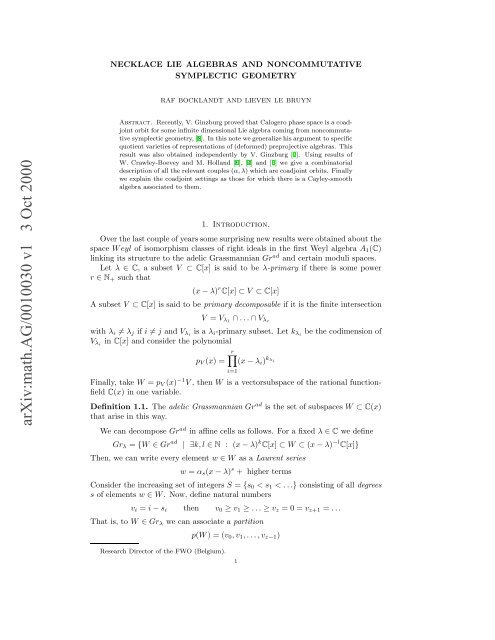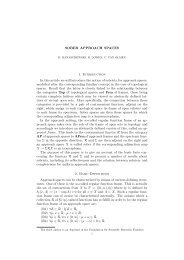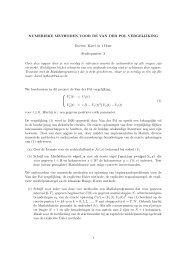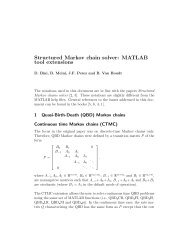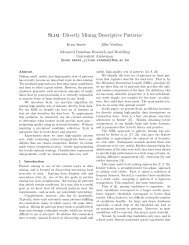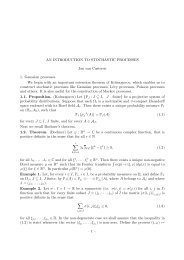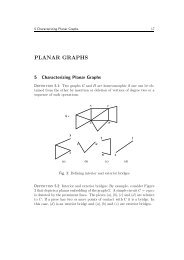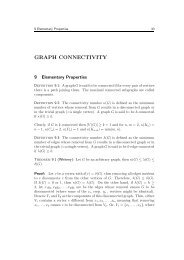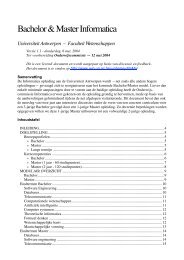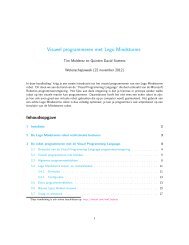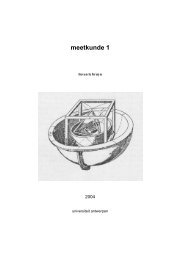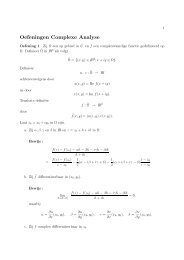Le Bruyn, Lieven; Necklace Lie algebras and noncommutative ...
Le Bruyn, Lieven; Necklace Lie algebras and noncommutative ...
Le Bruyn, Lieven; Necklace Lie algebras and noncommutative ...
You also want an ePaper? Increase the reach of your titles
YUMPU automatically turns print PDFs into web optimized ePapers that Google loves.
NECKLACE LIE ALGEBRAS AND NONCOMMUTATIVE SYMPLECTIC GEOMETRY 3An early indication that a decomposition into moduli spaces might be possiblecan be found in the paper [15] of the second author. Recently, a similar idea waspursued by A. Kapustin, A. Kutzetsov <strong>and</strong> D. Orlov [11].If we trace the action of Aut A 1 (C) on Weyl n through all the identifications,we get a transitive action of Aut A 1 (C) on Calo n . However, this action is nondifferentiablehence highly non-algebraic. Berest <strong>and</strong> Wilson asked whether it ispossible to identify Calo n with a coadjoint orbit in some infinite dimensional <strong>Lie</strong>algebra.This conjecture was proved by V. Ginzburg [8] using <strong>noncommutative</strong> symplecticgeometry as sketched by M. Kontsevich [14]. After reading his preprint it becameclear to us that his method could be used almost verbatim for the quotient varietiesof representations of deformed preprojective <strong>algebras</strong>. The two crucial stepsare (1) invariants of quiver representations are generated by traces along orientedcycles, proved in [17] <strong>and</strong> (2) acyclicity of the relative (!) <strong>noncommutative</strong> deRhamcohomology for path <strong>algebras</strong> of quivers.In the first sections of this paper we carry out the second project in some detail.When applied to the double Q of a quiver, the <strong>noncommutative</strong> functions acquirethe structure of an infinite dimensional <strong>Lie</strong> algebra N Q which we call the necklace <strong>Lie</strong>algebra of a quiver. A major result asserts that this <strong>Lie</strong> algebra is a central extensionof the <strong>Lie</strong> algebra of symplectic derivations, that is the <strong>Lie</strong> algebra corresponding tothe vertex-preserving automorphisms of the path algebra CQ preserving the momentelement m = ∑ a [a, a∗ ].Recall that the deformed preprojective algebra Π λ is defined to be the quotientof CQ by the twosided ideal generated by m − λ. Our generalization of Ginzburg’sresult on the coadjointness of Calogero space can then be stated as :Theorem 1.4. The variety iss α Π λ of isomorphism classes of semisimple α-dimensional representations of the deformed preprojective algebra Π λ is a coadjointorbit of the necklace <strong>Lie</strong> algebra N Q whenever α is a minimal non-zero element ofΣ λ the set of dimension vectors of simple representations of Π λ .W. Crawley-Boevey has given a combinatorial description of the set Σ λ in [4]. Werecover the Calogero case back <strong>and</strong> prove that the spaces appearing in a conjecturalextension to arbitrary extended Dynkin quivers (conjectured by M. Holl<strong>and</strong> <strong>and</strong> W.Crawley-Boevey) are all coadjoint orbits.In the last two sections we try to explain why precisely these (α, λ) couplesappear from the viewpoint of <strong>noncommutative</strong> geometry. As the path algebra CQis a formally smooth algebra as in [7], its representation spaces rep α Q are smoothvarieties <strong>and</strong> the <strong>noncommutative</strong> functions <strong>and</strong> differential forms induce invariantclassical functions <strong>and</strong> forms on these varieties <strong>and</strong> their quotient varieties. On theother h<strong>and</strong>, we will show that the deformed preprojective algebra Π λ is not formallysmooth <strong>and</strong> so should be viewed as a singular subvariety of the <strong>noncommutative</strong>manifold corresponding to CQ. As such, the <strong>noncommutative</strong> vectorfields on CQ(the <strong>Lie</strong> algebra N Q ) have rather unpredictable behavior on the singular closedsubvariety Π λ . However, for those dimension vectors α such that rep α Π λ is smooth(that is, Π λ is an α-smooth subvariety of CQ) things should work out. We conjecturethat the corresponding α are precisely the minimal elements in Σ λ (the coadjointorbits). We prove this for the preprojective algebra Π 0 <strong>and</strong> prove a variation (usinghyper-Kähler reductions) for Π λ . These results are based on the calculation ofExt 1 ’s of representations of Π 0 due to W. Crawley-Boevey [5].2. <strong>Necklace</strong> <strong>Lie</strong> <strong>algebras</strong>.In this section we introduce the main object of this note in a purely combinatorialway. Recall that a quiver Q is a finite directed graph on a set of vertices Q v ={v 1 , . . . , v k }, having a finite set Q a = {a 1 , . . .,a l } of arrows, where we allow loops as
4 RAF BOCKLANDT AND LIEVEN LE BRUYN• •• • • •• • ∑a∈Q aw1• • u • • a• • • v a ∗ • −• •w 2• u • a• • • v a ∗ • • ••w 2 ••• • ••w 1 ••• Figure 1. <strong>Lie</strong> bracket [w 1 , w 2 ] in N Q .well as multiple arrows between vertices. An arrow a with starting vertex s(a) = v i<strong>and</strong> terminating vertex t(a) = v j will be depicted as aj i . The quiverinformation is encoded in the Euler form which is the bilinear form on Z k determinedby the matrix χ Q ∈ M k (Z) withχ ij = δ ij − # { a ∈ Q a | j a i }The symmetrization T Q = χ Q + χ tr Q of this matrix determines the Tits form of thequiver Q. An oriented cycle c = a iu . . . a i1 of length u ≥ 1 is a concatenation ofarrows in Q such that t(a ij ) = s(a ij+1 ) <strong>and</strong> t(a iu ) = s(a i1 ). In addition to thesethere are k oriented cycles e i of length 0 corresponding to the vertices of Q. Alloriented cycles c ′ obtained from c by cyclically permuting the arrow componentsare said to be equivalent to c. A necklace word w for Q is an equivalence class oforiented cycles in the quiver Q.The double quiver Q of Q is the quiver obtained by adjoining to every arrow (orloop) j a i in Q an arrow in the opposite direction a ∗ j i . That is,χ Q = T Q − k .The necklace <strong>Lie</strong> algebra N Q for the quiver Q has as basis the set of all necklacewords w for the double quiver Q <strong>and</strong> where the <strong>Lie</strong> bracket [w 1 , w 2 ] is determinedas in figure 1. That is, for every arrow a ∈ Q a we look for an occurrence of ain w 1 <strong>and</strong> of a ∗ in w 2 . We then open up the necklaces by removing these factors<strong>and</strong> regluing the open ends together to form a new necklace word. We repeat thisoperation for all occurrences of a (in w 1 ) <strong>and</strong> a ∗ (in w 2 ). We then replace the rolesof a ∗ <strong>and</strong> a <strong>and</strong> redo this operation with a minus sign. Finally, we add up all theseobtained necklace words for all arrows a ∈ Q a . Using this graphical description itis a pleasant exercise to verify the Jacobi identity for N Q .3. An acyclicity result.The path algebra CQ of a quiver Q has as basis the set of all oriented pathsp = a iu . . . a i1 of length u ≥ 1 in the quiver, that is s(a ij+1 ) = t(a ij ) together withthe vertex-idempotents e i of length zero. Multiplication in CQ is induced by (left)concatenation of paths. More precisely, 1 = e 1 + . . . + e k is a decomposition of 1into mutually orthogonal idempotents <strong>and</strong> further we define• e j .a is always zero unless• a.e i is always zero unless j a in which case it is the path a, a i in which case it is the path a,
NECKLACE LIE ALGEBRAS AND NONCOMMUTATIVE SYMPLECTIC GEOMETRY 5• a i .a j is always zero unlessa i a j .a ia jin which case it is the pathPath <strong>algebras</strong> of quivers are the archetypical examples of formally smooth <strong>algebras</strong>as introduced <strong>and</strong> studied in [7].In this section we will generalize Kontsevich’s acyclicity result for the <strong>noncommutative</strong>deRham cohomology of the free algebra [14] to that of the path algebraCQ. The crucial idea is to consider the relative differential forms (as defined in [7])of CQ with respect to the semisimple subalgebra V = C × . . . × C generated by thevertex idempotents. The idea being that in considering quiver representations oneworks in the category of V -<strong>algebras</strong> rather than C-<strong>algebras</strong>.For a subalgebra B of A, let A B denote the cokernel of the inclusion as B-bimodule. The space of relative differential forms of degree n of A with respect toB isΩ n B A = A ⊗ B A B ⊗ B . . . ⊗ B A B} {{ }nThe space Ω • B A is given a differential graded algebra structure by taking the multiplicationn∑(a 0 , . . . , a n )(a n+1 , . . . , a m ) = (−1) n−i (a 0 , . . . , a i−1 , a i a i+1 , a i+2 , . . .,a m )i=0<strong>and</strong> the differential d(a 0 , . . .,a n ) = (1, a 0 , . . . , a n ), see [7]. Here, (a 0 , . . . , a n ) is arepresentant of the class a 0 da 1 . . . da n ∈ Ω n B A <strong>and</strong> we recall that Ω• B A s generatedby the a <strong>and</strong> da for all a ∈ A. The relative cohomology HB n A is defined as thecohomology of the complex Ω • B A.For θ ∈ Der B A, the <strong>Lie</strong> algebra of B-derivations of A (that is θ is a derivationof A <strong>and</strong> θ(B) = 0), we define a degree preserving derivation L θ <strong>and</strong> a degree −1super-derivation i θ on Ω • B Aby the rulesΩ n−1dBA Ω n B A Ωn+1 BAL θi θ L θi θ L θ{L θ (a) = θ(a)i θ (a) = 0dL θ (da) = d θ(a)i θ (da) = θ(a)for all a ∈ A. We have the Cartan homotopy formula L θ = i θ ◦ d + d ◦ i θ as bothsides are degree preserving derivations on Ω • B A <strong>and</strong> they agree on all the generatorsa <strong>and</strong> da for a ∈ A.<strong>Le</strong>mma 3.1. <strong>Le</strong>t θ, γ ∈ Der B A, then we have on Ω • B A the identities of operators{L θ ◦ i γ − i γ ◦ L θ = [L θ , i γ ] = i [θ,γ] = i θ◦γ−γ◦θL θ ◦ L γ − L γ ◦ L θ = [L θ , L γ ] = L [θ,γ] = L θ◦γ−γ◦θProof. Consider the first identity. By definition both sides are degree −1 superderivationson Ω • B A so it suffices to check that they agree on generators. Clearly,both sides give 0 when evaluated on a ∈ A <strong>and</strong> for da we have(L θ ◦ i γ − i γ ◦ L θ )da = L θ γ(a) − i γ d θ(a) = θ γ(a) − γ θ(a) = i [θ,γ] (da)A similar argument proves the second identity.
6 RAF BOCKLANDT AND LIEVEN LE BRUYNSpecialize to the quiver-case with A = CQ the path algebra <strong>and</strong> B = V = C kthe vertex algebra.<strong>Le</strong>mma 3.2. <strong>Le</strong>t Q be a quiver on k vertices, then a basis for Ω n V CQ is given bythe elementsp 0 dp 1 . . . dp nwhere p i is an oriented path in the quiver such that length p 0 ≥ 0 <strong>and</strong> length p i ≥ 1for 1 ≤ i ≤ n <strong>and</strong> such that the starting point of p i is the endpoint of p i+1 for all1 ≤ i ≤ n − 1.Proof. Clearly l(p i ) ≥ 1 when i ≥ 1 or p i would be a vertex-idempotent whence inV . <strong>Le</strong>t v be the starting point of p i <strong>and</strong> w the end point of p i+1 <strong>and</strong> assume thatv ≠ w, thenfrom which the assertion follows.p i ⊗ V p i+1 = p i v ⊗ V wp i+1 = p i vw ⊗ V p i+1 = 0Proposition 3.3. <strong>Le</strong>t Q be a quiver on k vertices, then the relative differentialform-algebra Ω • V CQ is formal. In fact, the complex is acyclic{HV 0 CQ ≃ C × . . . × C (k factors)CQ ≃ 0 ∀n ≥ 1H n VProof. Define the Euler derivation E on CQ by the rules thatE(e i ) = 0 ∀ 1 ≤ i ≤ k <strong>and</strong> E(a) = a ∀a ∈ Q aBy induction on the length l(p) of an oriented path p in the quiver Q one easilyverifies that E(p) = l(p)p. By induction one can also proof that L E (p 0 dp 1 . . . dp n ) =l(p 0 ) + · · · + l(p n ). This implies that L E is a bijection on each Ω i V CQ, where i > 1<strong>and</strong> on Ω 0 V CQ, L E has V as its kernel. By applying the Cartan homotopy formulafor L E , we obtain that the complex is acyclic.The complex Ω • VCQ induces the relative Karoubi complexdR 0 V CQ d ✲ dR1V CQ d ✲ dR2V CQ d ✲ . . .withdR n V CQ = Ω n V∑ CQni=0 [ Ωi VCQ, Ωn−iVCQ ]In this expression the brackets denote supercommutators with respect to the gradingon Ω • V CQ. In the commutative case, dR0 are the functions on the manifold <strong>and</strong>dR 1 the 1-forms.<strong>Le</strong>mma 3.4. A C-basis for the <strong>noncommutative</strong> functionsdR 0 CQV CQ ≃[ CQ, CQ ]are the necklace words in the quiver Q.Proof. <strong>Le</strong>t W be the C-space spanned by all necklace words w in Q <strong>and</strong> define alinear map{CQ n ✲p ↦→ w p if p is a cycleWp ↦→ 0 if p is notfor all oriented paths p in the quiver Q, where w p is the necklace word in Q determinedby the oriented cycle p. Because w p1p 2= w p2p 1it follows that the commutatorsubspace [CQ, CQ] belongs to the kernel of this map. Conversely, letx = x 0 + x 1 + . . . + x m
NECKLACE LIE ALGEBRAS AND NONCOMMUTATIVE SYMPLECTIC GEOMETRY 7be in the kernel where x 0 is a linear combination of non-cyclic paths <strong>and</strong> x i for1 ≤ i ≤ m is a linear combination of cyclic paths mapping to the same necklaceword w i , then n(x i ) = 0 for all i ≥ 0. Clearly, x 0 ∈ [CQ, CQ] as we can write everynoncyclic path p = a.p ′ = a.p ′ −p ′ .a as a commutator. If x i = a 1 p 1 +a 2 p 2 +. . .+a l p lwith n(p i ) = w i , then p 1 = q.q ′ <strong>and</strong> p 2 = q ′ .q for some paths q, q ′ whence p 1 − p 2 isa commutator. But then, x i = a 1 (p 1 − p 2 ) + (a 2 − a 1 )p 2 + . . . + a l p l is a sum of acommutator <strong>and</strong> a linear combination of strictly fewer elements. By induction, thisshows that x i ∈ [CQ, CQ].<strong>Le</strong>mma 3.5. dR 1 VCQ is isomorphic as C-space toj⊕a iv i .CQ.v j da =j⊕a ii jd ja iProof. If p.q is not a cycle, then pdq = [p, dq] <strong>and</strong> so vanishes in dR 1 V CQ so we onlyhave to consider terms pdq with p.q an oriented cycle in Q. For any three paths p, q<strong>and</strong> r in Q we have the equality[p.qdr] = pqdr − qd(rp) + qrdpwhence in dR 1 V CQ we have relations allowing to reduce the length of the differentialpartqd(rp) = pqdr + qrdpso dR 1 V CQ is spanned by terms of the form pda with a ∈ Q a <strong>and</strong> p.a an orientedcycle in Q. Therefore, we have a surjectionΩ 1 V CQ ✲ ⊕v i .CQ.v j dajBy construction, it is clear that [Ω 0 V CQ, Ω1 relCQ] lies in the kernel of this map <strong>and</strong>using an argument as in the lemma above one shows also the converse inclusion.Using the above descriptions of dR i V CQ for i = 0, 1 <strong>and</strong> the differentialdR 0 V CQ d ✲ dR1V CQ we can define partial differential operators associated toaany arrow j i in Q.a i∂∂a : dR0 rel CQ ✲ v i CQv j by df = ∑a∈Q a∂f∂a daTo take the partial derivative of a necklace word w with respect to an arrow a, werun through w <strong>and</strong> each time we encounter a we open the necklace by removingthat occurrence of a <strong>and</strong> then take the sum of all the paths obtained.Defining the relative deRham cohomology HdR n CQ to be the cohomology of theKaroubi complex <strong>and</strong> observing that the operators L θ <strong>and</strong> i θ on Ω • V CQ induceoperators on the Karoubi complex, we have the acyclicity resultTheorem 3.6. The relative Karoubi complex is acyclic. In particular,{HdR 0 CQ ≃ VCQ ≃ 0 ∀n ≥ 1H n dR
8 RAF BOCKLANDT AND LIEVEN LE BRUYN4. Symplectic interpretation.In this section we use the acyclicity result to give a Poisson interpretation to the<strong>Lie</strong> bracket in N Q . This generalizes the Kontsevich bracket [14] in the free case topath <strong>algebras</strong> of doubles of quivers. If Q is a quiver with double quiver Q, then wecan define a canonical symplectic structure on the path algebra of the double CQdetermined by the elementω = ∑a∈Q ada ∗ da ∈ dR 2 V CQAs in the commutative case, ω defines a bijection between the <strong>noncommutative</strong>1-forms dR 1 V CQ <strong>and</strong> the <strong>noncommutative</strong> vectorfields which are defined to be theV -derivations of CQ. This correspondence isDer V CQ τ ✲ dR1V CQ given by τ(θ) = i θ(ω)In analogy with the commutative case we define a derivation θ ∈ Der V CQ to besymplectic if <strong>and</strong> only if L θ ω = 0 ∈ dR 2 V CQ <strong>and</strong> denote the subspace of symplecticderivations by Der ω CQ. It follows from the homotopy formula <strong>and</strong> the fact thatω is a closed form, that θ ∈ Der ω CQ implies L θ ω = di θ ω = dτ(θ) = 0. That is,τ(θ) is a closed form which by the acyclicity of the Karoubi complex shows thatit must be an exact form. That is we have an isomorphism of exact sequences ofC-vectorspaces0 ✲ V ✲ dR0V CQ d ✲ (dR1V CQ) exact✲ 0=❄❄0 ✲ V ✲CQ[CQ, CQ]≃τ −1 ❄✲ Derω CQ✲ 0The symplectic structure ω defines a Poisson bracket on the <strong>noncommutative</strong> functions.Definition 4.1. <strong>Le</strong>t Q be a quiver <strong>and</strong> Q its double. The Kontsevich bracket onthe necklace words in Q, dR 0 V CQ is defined to be{w 1 , w 2 } K = ∑( ∂w 1 ∂w 2∂a ∂a ∗ − ∂w 1 ∂w 2∂a ∗ ) mod [CQ, CQ]∂aa∈Q aBy the description of the partial differential operators it is clear that dR 0 V CQ withthis bracket is isomorphic to the necklace <strong>Lie</strong> algebra N Q .The symplectic derivations Der ω CQ have a natural <strong>Lie</strong> algebra structure bycommutators of derivations. We will show that τ −1 ◦ d is a <strong>Lie</strong> algebra morphism.For every necklace word w we have a symplectic derivation θ w = τ −1 dw definedby{θ w (a)θ w (a ∗ )= − ∂w∂a ∗= ∂w∂aWith this notation we get the following interpretations of the Kontsevich bracket{w 1 , w 2 } K = i θw1 (i θw2 ω) = L θw1 (w 2 ) = −L θw2 (w 1 )where the next to last equality follows because i θw2 ω = dw 2 <strong>and</strong> the fact thati θw1 (dw) = L θw1 (w) for any w. More generally, for any V -derivation θ <strong>and</strong> anynecklace word w we have the equationi θ (i θw ω) = L θ (w).
NECKLACE LIE ALGEBRAS AND NONCOMMUTATIVE SYMPLECTIC GEOMETRY 9When we look at the image of the Kontsevich bracket under τ −1 d, we obtain thefollowingτ −1 d{w 1 , w 2 } K = τ −1 dL θw1 w 2= τ −1 L θw1 dw 2= τ −1 L θw1 i θw2 ω= τ −1 ([L θw1 , i θw2 ] + i θw2 L θw1 )ω= τ −1 i [θw1 ,θ w2 ]ω= [θ w1 , θ w2 ]Above we made use of the fact that L θ commutes with d, <strong>and</strong> the defining equationdw 2 = i θw2 ω. In the fourth line we omitted the last term because θ w1 is a symplecticderivation. Finally lemma 3.1 enabled us to transform the commutator in i <strong>and</strong> Lto of commutator of the derivations θ w1 <strong>and</strong> θ w2 . This calculation concluded theproof of :Theorem 4.2. With notations as before, dR 0 rel CQd with the Kontsevich bracketis isomorphic to the necklace <strong>Lie</strong> algebra N Q , <strong>and</strong> the sequence0 ✲ V ✲ NQτ −1 d✲ Derω CQ ✲ 0is an exact sequence (hence a central extension) of <strong>Lie</strong> <strong>algebras</strong>.5. Coadjoint orbits.Consider a dimension vector α = (n 1 , . . . , n k ), that is, a k-tuple of natural numbers,then the space of α-dimensional representations of the double quiver Q, rep α Qcan be identified via the trace pairing with the cotangent bundle T ∗ rep α Q of thespace of α-dimensional representations of the quiver Q, see for example [4], <strong>and</strong> assuch acquires a natural symplectic structure. The natural action of the basechangegroup GL(α) = GL n1 × . . . × GL nk on rep α Q is symplectic <strong>and</strong> induces a Poissonstructure on the coordinate ring as well as on the ring of polynomial quiverinvariants, which are generated by traces along oriented cycles by [17].The symplectic derivations Der ω CQ correspond to the V -automorphisms of thepath algebra of the double CQ preserving the moment elementm = ∑[a, a ∗ ] ∈ CQa∈Q aFor this reason it is natural to consider the complex moment maprep α Q µ C✲ M0α (C) V ↦→ ∑a∈Q a[V a , V a ∗]where Mα 0(C) is the subspace of k-tuples (m 1, . . .,m k ) ∈ M n1 (C) ⊕ . . . ⊕ M nk (C)such that ∑ i tr(m i) = 0, that is Mα 0 (C) = <strong>Lie</strong> PGL(α) where PGL(α) =GL(α)/C ∗ ( n1 , . . . , nk ).For λ = (λ 1 , . . .,λ k ) ∈ C k such that ∑ i n iλ i = 0 we consider the elementλ = (λ1 n1 , . . .,λk nk ) in Mα(C). 0 The inverse image µ −1C(λ) is a GL(α)-closedaffine subvariety of rep α Q.In [9] V. Ginzburg proved the following coadjointness result using the results ofthe preceding sections.Theorem 5.1 (Ginzburg). Assume that µ −1C(λ) is irreducible <strong>and</strong> that PGL(α)acts freely on µ −1C(λ), then the quotient variety (the orbit space)µ −1C (λ)/GL(α)is a coadjoint orbit for the necklace <strong>Lie</strong> algebra N Q .
10 RAF BOCKLANDT AND LIEVEN LE BRUYNUsing results of W. Crawley-Boevey [4] we will identify the situations (α, λ)satisfying the conditions of the theorem. For λ ∈ C k as above, W. Crawley-Boevey<strong>and</strong> M. Holl<strong>and</strong> introduced <strong>and</strong> studied the deformed preprojective algebraΠ λ =CQ(m − λ)where λ = λ 1 e 1 + . . . + λ k e k ∈ CQ. From [6] we recall that µ −1C(λ) is the scheme ofα-dimensional representations rep αΠ λ of the deformed preprojective algebra Π λ .We recall the characterization due to V. Kac [10] of the dimension vectors ofindecomposable representations of the quiver Q. To a vertex v i in which Q has noloop, we define a reflection Z k r✲ iZ k byr i (α) = α − T Q (α, ǫ i )ǫ iwhere ǫ i = (δ 1i , . . .,δ ki ). The Weyl group of the quiver Q Weyl Q is the subgroupof GL k (Z) generated by all reflections r i .A root of the quiver Q is a dimension vector α ∈ N k such that rep α Q containsindecomposable representations. All roots have connected support. A root is saidto be{real if χ Q (α, α) = 1imaginary if χ Q (α, α) ≤ 0For a fixed quiver Q we will denote the set of all roots, real roots <strong>and</strong> imaginary rootsrespectively by ∆, ∆ re <strong>and</strong> ∆ im . With Π we denote the set {ǫ i | v i has no loops }.The fundamental set of roots is defined to be the following set of dimension vectorsF Q = {α ∈ N k − 0 | T Q (α, ǫ i ) ≤ 0 <strong>and</strong> supp(α) is connected }Kac’s result asserts that{∆ re∆ im= Weyl Q .Π ∩ N k= Weyl Q .F Q ∩ N kExample 5.2. The quiver Q <strong>and</strong> double quiver Q appearing in the study ofCalogero phase space (see [20] <strong>and</strong> [8]) which stimulated the above generalizationsarea b <strong>and</strong> aa ∗bb ∗The Euler- <strong>and</strong> Tits form of the quiver Q are determined by the matricesχ Q =[ ]1 −10 0<strong>and</strong> T Q =[2]−1−1 0
NECKLACE LIE ALGEBRAS AND NONCOMMUTATIVE SYMPLECTIC GEOMETRY 11The root-system for Q is easy to work out. We havenF Q ∆+im •∆ + re⎧⎪⎨ F Q = {(m, n) | n ≥ 2m}∆ + im= {(m, n) | n ≥ n}⎪⎩Π = ∆ + re = {(1, 0)}Fix λ ∈ C k <strong>and</strong> denote ∆ + λ to be the set of positive roots β = (b 1, . . . , b k ) forQ such that λ.β = ∑ i λ ib i = 0. With S λ (resp. Σ λ ) we denote the subsets ofdimension vectors α which are roots for Q such that1 − χ Q (α, α) ≥ (resp. >) r − χ Q (β 1 , β 1 ) − . . . − χ Q (β r , β r )for all decompositions α = β 1 + . . . + β r with the β i ∈ ∆ + λ. The main results of [4]can be summarized into :Theorem 5.3 (W. Crawley-Boevey). 1. α ∈ S 0 if <strong>and</strong> only if µ C is a flat morphism.In this case, µ C is also surjective.2. α ∈ Σ λ if <strong>and</strong> only if Π λ has a simple α-dimensional representation. In thiscase, µ −1C(λ) is a reduced <strong>and</strong> irreducible complete intersection of dimension1 + α.α − 2χ Q (α, α).Using the results of [17] one verifies that the set of dimension vectors of simplerepresentations of Q coincides with the fundamental set F Q . As any simple Π λ -representation is a simple Q-representations it follows that Σ λ⊂ ✲ FQ .Example 5.4. For the Calogero-example above, we have1. The set S 0 consisting of all (m, n) such that the complex moment map µ C issurjective <strong>and</strong> flat is the set of rootsS 0 = {(m, n) | n ≥ 2m − 1} ⊔ {(1, 0)}2. The set Σ 0 of dimension vectors (m, n) of simple representations of the preprojectivealgebra Π 0 is the set of rootsΣ 0 = {(m, n) | n ≥ 2m} ⊔ {(1, 0)}which is F Q ⊔ {(1, 0)}.3. For λ = (−n, m) with gcd(m, n) = 1, the set Σ λ of dimension vectors of simplerepresentations of the deformed preprojective algebra is the set of rootsΣ λ = {k.(m, n) | k ∈ N + }with unique minimal element (m, n).For the first two parts the essential calculation is to verify the conditions on thedecomposition (m, n) = (m − 1, n) + (1, 0).We obtain the following combinatorial description of the couples (α, λ) for whichGinzburg’s criterium applies.m
12 RAF BOCKLANDT AND LIEVEN LE BRUYNTheorem 5.5. µ −1C(λ) is irreducible with a free action of PGL(α) (<strong>and</strong> henceµ −1C (λ)/GL(α) is a coadjoint orbit for N Q) if <strong>and</strong> only if α is a minimal non-zeroelement of Σ λ .Proof. We know that µ −1C (λ) = rep α Π λ. By a result of M. Artin [1] one knows thatthe geometric points of the quotient scheme rep αΠ λ /GL(α) are the isomorphismclasses of α-dimensional semi-simple representations of Π λ . Moreover, the PGL(α)-stabilizer of a point in rep αΠ λ is trivial if <strong>and</strong> only if it determines a simpleα-dimensional representation of Π λ . The result follows from this <strong>and</strong> the resultsrecalled above.Example 5.6. Consider the special case when λ = (−n, 1) <strong>and</strong> α = (1, n) theunique minimal element in Σ λ , then it follows from [20] that we have canonicalidentifications of the quotient varietiesiss α Π λ ≃ Calo nwhere Calo n is the phase space of n Calogero particles. In particular, Calo n is acoadjoint orbit. Wilson [20] has shown thatGr ad = ⊔ nCalo nwhere Gr ad is the adelic Grassmannian which can be thought of as the spaceparametrizing isomorphism classes of right ideals in the first Weyl algebra A 1 (C) =C〈x, y〉/(xy − yx − 1) by [3]. In [2] it is shown that there is a non-differentiableaction of the automorphism group of A 1 (C) on Gr ad having a transitive action oneach of the Calo n . It was then conjectured by Y. Berest <strong>and</strong> G. Wilson that Calo nmight be a coadjoint orbit for a central extension of the automorphism group.Example 5.7. M. Holl<strong>and</strong> <strong>and</strong> W. Crawley-Boevey have a conjectural extensionof the foregoing example. <strong>Le</strong>t Q ′ be an extended Dynkin quiver on k vertices{v 1 , . . . , v k } with minimal imaginary root δ = (d 1 , . . . , d k ). A vertex v i is said tobe an extending vertex provided d i = 1. Consider the quiver Q on k + 1 vertices{v 0 , v 1 , . . . , v k } which is Q ′ on the last k vertices <strong>and</strong> there is one extra arrowfrom v o to an extending vertex v i . For a generic λ ′ = (λ 1 , . . .,λ k ) they defined a<strong>noncommutative</strong> algebra O λ′ extending the role of the Weyl algebra in the previousexample. They conjecture that there is a bijection between the isomorphism classesof stably free right ideals in O λ <strong>and</strong> points in⊔ n µ −1C (λ n)/GL(α n )where α n = (1, nδ) <strong>and</strong> λ n = (−nλ ′ .δ, λ ′ ). This remains to be seen but fromour theorem we deduce that each of the quotient varieties µ −1C (λ n)/GL(α n ) is acoadjoint orbit for the necklace <strong>Lie</strong> algebra N Q .If α ∈ Σ λ but not minimal, there are several representation types τ =(m 1 , β 1 ; . . .,m v , β v ) of semi-simple α-dimensional representations of Π λ with theβ i ∈ Σ λ <strong>and</strong> ∑ m i β i = α <strong>and</strong> the m i determine the multiplicities of the simplecomponents. With iss α (τ) we denote the subvariety of the quotient varietyiss α Π λ = rep α Π λ /GL(α) consisting of all semi-simple representations of type τ.Consider the algebra A Q = C[N Q ] ⊗ C CQ which has a natural trace map tr :A Q✲ C[NQ ] mapping an oriented cycle in Q to the corresponding necklace word<strong>and</strong> all open paths to zero. With Aut Q we denote the automorphism group of tracepreserving C-algebra automorphisms of A Q which preserve the moment elementm = ∑ a∈Q a[a, a ∗ ]. A natural extension of the above coadjoint orbit result wouldbe a positive solution to the following problem.Question 5.8. Does Aut Q act transitively on every stratum iss α (τ) ?
NECKLACE LIE ALGEBRAS AND NONCOMMUTATIVE SYMPLECTIC GEOMETRY 136. The smooth locus of Π 0 .In this section <strong>and</strong> the next we try to explain why exactly the couples (α, λ) withλ.α = 0 <strong>and</strong> α a minimal non-zero element of Σ λ give rise to coadjoint orbits.The path algebra CQ of the double quiver Q is formally smooth in the sense of[7], that is, it has the lifting property with respect to nilpotent ideals. Hence, CQis the coordinate ring of a <strong>noncommutative</strong> affine manifold <strong>and</strong> has a good theoryof differential forms (acyclicity).On the other h<strong>and</strong>, we will see that the deformed preprojective <strong>algebras</strong> Π λ arenever formally smooth. For this reason, the differential forms of CQ when restrictedto Π λ may have rather unpredictable behavior.Still, it may be possible that certain representation spaces rep α Π λ are smooth<strong>and</strong> we need a notion of <strong>noncommutative</strong> (formal) smoothness depending on thedimension vector α. This notion is Cayley-smoothness as introduced by C. Procesiin [19] <strong>and</strong> studied in detail in [16].<strong>Le</strong>t α = (n 1 , . . . , n k ) <strong>and</strong> set n = ∑ i n i. With alg @ α we denote the categoryof all V -<strong>algebras</strong> A equipped with a trace map tr : A ✲ A (that is, such thatfor all a, b ∈ A we have tr(a)b = btr(a), tr(ab) = tr(ba) <strong>and</strong> tr(tr(a)b) = tr(a)tr(b))satisfying tr(1) = n <strong>and</strong> the formal Cayley-Hamilton identity of degree n, see [19]such that tr(e i ) = n i . Morphisms in alg @ α are trace preserving algebra morphisms.An α-Cayley smooth algebra A is an algebra in alg @ α having the lifting propertywith respect to nilpotent ideals in alg @ α . That is, every diagramBπ ✲ B I■ . . ............✻φ∃˜φwith B, B I in alg @ α, I a nilpotent ideal <strong>and</strong> π <strong>and</strong> φ trace preserving maps, canbe completed with a trace preserving algebra map ˜φ. It is proved in [16] that A isα-Cayley smooth if <strong>and</strong> only if the scheme rep αA of α-dimensional representationsof A is a smooth GL(α)-variety.In particular, if (λ, α) is such that λ.α = 0 <strong>and</strong> α is a minimal non-zero vector inΣ λ , then the level α approximation Π λ @ α (which is the ring of GL(α)-equivariantmaps from rep αΠ λ to M n (C) with the induced trace from M n (C[rep αΠ λ )) is α-Cayley smooth. In fact, Π λ @ α is an Azumaya algebra over the coadjoint orbit. Aneat explanation for the description of the coadjoint orbits would be provided by apositive solution to the following problem.Question 6.1. Conversely, if Π λ @ α is α-Cayley smooth, does it follow that α isa minimal non-zero vector in Σ λ ? More generally, does the α-smooth locus ofΠ λ @ α , that is the locus Sm α Π λ in iss α Π λ such that rep αΠ α is smooth alongπ −1 (Sm Π λ ), coincide with the Azumaya locus ?We will give an affirmative solution in the special case of the preprojective algebraΠ 0 . By a result of W. Crawley-Boevey [5], we can control the Ext 1 -spaces ofrepresentations of Π 0 . <strong>Le</strong>t V <strong>and</strong> W be representations of Π 0 of dimension vectorsα <strong>and</strong> β, then we havedim C Ext 1 Π 0(V, W) = dim C Hom Π0 (V, W) + dim C Hom Π0 (W, V ) − T Q (α, β)For ξ ∈ iss α Π 0 to belong to the smooth locus ξ ∈ Sm α Π 0 it is necessary <strong>and</strong>sufficient that rep αΠ 0 is smooth along the orbit O(M ξ ) where M ξ is the semisimpleα-dimensional representation of Π 0 corresponding to ξ.A
14 RAF BOCKLANDT AND LIEVEN LE BRUYNAssume that ξ is of type τ = (e 1 , α 1 ; . . .;e z , α z ), that is,M ξ = S ⊕e11 ⊕ . . . ⊕ Sz⊕ezwith S i a simple Π 0 -representation of dimension vector α i . Then, the normal spaceto the orbit O(M ξ ) is determined by Ext 1 Π o(M ξ , M ξ ) <strong>and</strong> can be depicted by a localquiver setting (Q ξ , α ξ ) where Q ξ is a quiver on z vertices having as many arrowsfrom vertex i to vertex j as the dimension of Ext 1 Π 0(S i , S j ) <strong>and</strong> where α ξ = α τ =(e 1 , . . . , e z ). Applying the Luna slice theorem [18] we have<strong>Le</strong>mma 6.2. With notations as above, ξ ∈ Sm α Π 0 if <strong>and</strong> only ifdim GL(α) × GL(α ξ) Ext 1 Π 0(M ξ , M ξ ) = dim Mξ rep αΠ 0As we have enough information to compute both sides, we can prove :Theorem 6.3. If ξ ∈ iss α Π 0 with α = (a 1 , . . . , a k ) ∈ S 0 , then ξ ∈ Sm α Π 0 if<strong>and</strong> only if M ξ is a simple n-dimensional representation of Π 0 . That is, the smoothlocus of Π 0 coincides with the Azumaya locus.Proof. Assume that ξ is a point of semi-simple representation type τ =(e 1 , α 1 ; . . . ; e z , α z ), that is,M ξ = S ⊕e11 ⊕ . . . ⊕ S ⊕ezz with dim(S i ) = α i<strong>and</strong> S i a simple Π 0 -representation. We have{dim C Ext 1 Π 0(S i , S j ) = −T Q (α i , α j )dim C Ext 1 Π 0(S i , S i ) = 2 − T Q (α i , α i )i ≠ jBut then, the dimension of Ext 1 Π 0(M ξ , M ξ ) is equal toz∑i=1(2 − T Q (α i , α i ))e 2 i + ∑ i≠jfrom which it follows immediately thate i e j (−T Q (α i , α j ) = 2dim GL(α) × GL(α ξ) Ext 1 Π 0(M ξ , M ξ ) = α.α +On the other h<strong>and</strong>, as α ∈ S 0 we know thatz∑e i − T Q (α, α)i=1z∑e 2 i − T Q(α, α)dim rep αΠ 0 = α.α − 1 + 2p Q (α) = α.α − 1 + 2 − 2χ Q (α, α) = α.α + 1 − T Q (α, α)But then, equality occurs if <strong>and</strong> only if ∑ i e2 i = 1, that is, τ = (1, α) or M ξ is asimple n-dimensional representation of Π 0 .In particular it follows that the preprojective algebra Π 0 is never formally smoothas this implies that all the representation varieties must be smooth. Further, as⃗v i = (0, . . .,1, 0, . . .,0) are dimension vectors of simple representations of Π 0 itfollows that Π 0 is α-smooth if <strong>and</strong> only if α = ⃗v i for some i.Example 6.4. <strong>Le</strong>t Q be an extended Dynkin diagram <strong>and</strong> δ the minimal imaginaryroot, then δ ∈ S 0 . The dimension of the quotient varietyi=1dim iss δ Π 0 = dim rep δ Π 0 − δ.δ + 1= 2so it is a surface. The only other semi-simple δ-dimensional representation of Π 0 isthe trivial representation. By the theorem, this must be an isolated singular point ofiss δ Q. In fact, one can show that iss δ Π 0 is the Kleinian singularity correspondingto the extended Dynkin diagram Q.
NECKLACE LIE ALGEBRAS AND NONCOMMUTATIVE SYMPLECTIC GEOMETRY 157. A sheaf of <strong>algebras</strong>.We will prove that α-Cayley smoothness of a closely related sheaf of <strong>algebras</strong>is equivalent to α being a minimal non-zero vector of Σ λ . Recall that rep α Qadmits a hyper-Kähler structure (that is, an action of the quaternion algebra H =R.1 ⊕ R.i ⊕ R.j ⊕ R.k) defined for all arrows a ∈ Q a <strong>and</strong> all arrows b ∈ Q a by theformulae, see for example [5](i.V ) b = iV b(j.V ) a = −V † a ∗ (j.V ) a ∗ = V a†(k.V ) a = −iV † a ∗ (k.V ) a ∗ = iV a†where this time we denote the Hermitian adjoint of a matrix M by M † to distinguishit from the star-operation on the arrows of the double quiver Q. <strong>Le</strong>t U(α) be theproduct of unitary groups U n1 × . . . × U nk <strong>and</strong> consider the real moment maprep α Q µ ✲ R∑ i<strong>Lie</strong> U(α) V ↦→2 [V b, V †b ]For λ ∈ R k , multiplication by the quaternion-element h = i+k √2gives a homeomorphismbetween the real varietiesµ −1C(λ) ∩ µ−1R (0) bb∈Qah. ✲ µ−1C(0) ∩ µ−1R (iλ)Moreover, the hyper-Kähler structure commutes with the base-change action ofU(α), whence we have a natural one-to-one correspondence between the quotientspaces(µ −1C(λ) ∩ µ−1R (0))/U(α)h. ✲ (µ−1C(0) ∩ µ−1R (iλ))/U(α)see [5] for more details. By results of Kempf <strong>and</strong> Ness [12] we can identify theleft h<strong>and</strong> side as the quotient variety iss α Π λ <strong>and</strong> by results of A. King [13] wecan identify the right h<strong>and</strong> side as the moduli space Mα ss (Π 0 , λ) of λ-semistableα-dimensional representations of the preprojective algebra Π 0 . Recall that a representationV ∈ rep α Q is said to be λ-(semi)stable if <strong>and</strong> only if for every propersubrepresentation W of V say with dimension vector β we have λ.β > 0 (resp.λ.β ≥ 0). The scheme rep ss(Πα0, λ) of λ-semistable α-dimensional representationsof Π 0 is the intersection of µ −1C(0) with the subvariety of λ-semistable representationsin rep α Q. The corresponding moduli space Mα ss (Π 0 , λ) classifies isomorphismclasses of direct sums of λ-stable representations of Π 0 of total dimension α. Inview of the explicit form of the hyper-Kähler structure it follows that the deformedpreprojective algebra Π λ has semi-simple representations of dimension vector α ofrepresentation type τ = (e 1 , β 1 ; . . . ; e r , β r ) if <strong>and</strong> only if the preprojective algebraΠ 0 has λ-stable representations of dimension vectors β i for all 1 ≤ i ≤ r. In particular,Π θ has a simple representation of dimension vector α if <strong>and</strong> only if Π 0 has aθ-stable representation of dimension vector α.Taking locally the <strong>algebras</strong> of GL(α)-equivariant maps from rep ss(Πα0, λ) toM n (C) defines a sheaf of <strong>algebras</strong> in alg @ α , A λ,α on the moduli space Mα ss(Π0, λ).The main result of this section asserts the following.Theorem 7.1. With notations as above, for α ∈ Σ λ the following are equivalent :1. A λ,α is a sheaf of α-Cayley smooth <strong>algebras</strong> on the moduli space M ssα (Π 0, λ).2. α is a minimal non-zero vector in Σ λ (<strong>and</strong> hence the quotient variety iss α Π λis a coadjoint orbit for the necklace <strong>Lie</strong> algebra N Q ).Proof. As α ∈ Σ λ we know that iss α Π λ has dimension 1 + α.α − 2χ Q (α, α) −dim PGL(α) which is equal to 2 − T Q (α, α). By the hyper-Kähler correspondence
16 RAF BOCKLANDT AND LIEVEN LE BRUYNso is the dimension of Mα ss (Π 0 , λ), whence the open subset of µ −1C(0) consisting ofλ-semistable representations has dimension1 + α.α − 2χ Q (α, α)as there are λ-stable representations in it (again via the hyper-Kähler correspondence).Take a GL(α)-closed orbit O(V ) in this open set. That is, V is the directsum of λ-stable subrepresentationsV = S ⊕e11 ⊕ . . . ⊕ Sr⊕erwith S i a λ-stable representation of Π 0 of dimension vector β i occurring in V withmultiplicity e i whence α = ∑ i e iβ i .Again, the normal space in V to O(V ) can be identified with Ext 1 Π 0(V, V ). Asall S i are Π 0 -representations we can determine this space by the knowledge of allExt 1 Π 0(S i , S j ).Ext 1 Π 0(S i , S j ) = 2δ ij − T Q (β i , β j )But then the dimension of the normal space to the orbit isr∑dim Ext 1 Π 0(V, V ) = 2 e i − T Q (α, α)By the Luna slice theorem [18], the étale local structure in the smooth point Vis of the form GL(α) × GL(τ) Ext 1 (V, V ) where τ = (e 1 , . . .,e r ) <strong>and</strong> is therefore ofdimension2∑α.α + e 2 i − T Q(α, α)i=1This number must be equal to the dimension of the subvariety of λ-semistablerepresentations of Π 0 which has dimension 1 + α.α − T Q (α, α) if <strong>and</strong> only if r = 1<strong>and</strong> e 1 = 1, that is if <strong>and</strong> only if V is λ-stable. Hence, if rep ssα (Π 0 , λ) is smooth,then α must be a minimal non-zero vector in the set of dimension vectors of λ-stable representations of Π 0 <strong>and</strong> hence by the hyper-Kähler correspondence, α is aminimal non-zero vector in Σ λ .Conversely, if α is a minimal vector in Σ λ , then iss α Π λ is a coadjoint orbit,whence smooth <strong>and</strong> hence so is Mα ss (Π 0 , λ) by the correspondence. Moreover,all α-dimensional λ-semistable representations must be λ-stable by the minimalityassumption <strong>and</strong> so rep ssα (Π 0, λ) is a principal PGL(α)-fibration over Mα ss(Π0, λ)whence smooth. Therefore, A λ,α is a sheaf of α-Cayley smooth <strong>algebras</strong>.Question 6.1 can be proved as in the case of Π 0 provided we know thatdim C Ext 1 Π λ(M, N) = dim C Hom Πλ (M, N) + dim C Hom Πλ (N, M)− T Q (dim M, dim N)for all (simple) Π λ representations M <strong>and</strong> N. Still, we can prove that Π λ can neverbe formally smooth <strong>and</strong> even that certain representation varieties are not smooth.Proposition 7.2. <strong>Le</strong>t α ∈ Σ λ such that 2α ∈ Σ λ . Then, rep 2αΠ λ is not smooth.In particular, Π λ is not formally smooth.Proof. As α ∈ Σ λ we know that the local quiver Q ξ in a simple representation Scorresponding to ξ is a one vertex quiver having 2 − T Q (α, α) loops. That is,i=1dim Ext 1 Π λ(S, S) = 2 − T Q (α, α)But then, for ξ ∈ iss 2α Π λ a point corresponding to S ⊕ S, the local quiver is stillQ ξ but this time the local dimension vector α ξ = 2. If ξ lies in the smooth locus,then by the Luna slice theorem we must havedim GL(2α) × GL2 rep αξ Q ξ = dim rep 2α Π λ
NECKLACE LIE ALGEBRAS AND NONCOMMUTATIVE SYMPLECTIC GEOMETRY 17The left h<strong>and</strong> side is 4α.α + 4 − 4T Q (α, α) whereas the right h<strong>and</strong> side is equal to(because 2α ∈ Σ λ ) 4α.α + 1 − 4T Q (α, α), a contradiction.References[1] M. Artin, On Azumaya <strong>algebras</strong> <strong>and</strong> finite dimensional representations of rings, J.Alg. 11(1969) 523-563[2] Yu. Berest <strong>and</strong> G. Wilson Automorphisms <strong>and</strong> ideals of the Weyl algebra preprint, London(1999)[3] R. Cannings <strong>and</strong> M. Holl<strong>and</strong> Right ideals of rings of differential operators J.Alg. 167 (1994)116-141[4] W. Crawley-Boevey Geometry of the moment map for representations of quivers preprint<strong>Le</strong>eds (1999)[5] W. Crawley-Boevey On the exceptional fibers of Kleinian singularities preprint <strong>Le</strong>eds (1999)[6] W. Crawley-Boevey <strong>and</strong> M. Holl<strong>and</strong> Noncommutative deformations of Kleinian singularitiesDuke Math. J. (1998) 605-635[7] J. Cuntz <strong>and</strong> D. Quillen Algebra extensions <strong>and</strong> nonsingularity Journal AMS 8 (1995) 251-289[8] V. Ginzburg Non-commutative symplectic geometry <strong>and</strong> Calogero-Moser space preprintChicago, preliminary version (1999)[9] V. Ginzburg Non-commutative symplectic geometry, quiver varieties <strong>and</strong> operads preprintChicago (2000)[10] V. Kac Infinite root systems, representations of graphs <strong>and</strong> invariant theory Invent. Math.56 (1980) 57-92[11] A. Kapustin, A. Kuznetson <strong>and</strong> D. Orlov Noncommutative instantons <strong>and</strong> twistor transformhep-th/0002193 (2000)[12] G.Kempf <strong>and</strong> L. Ness The length of a vector in representation space LNM 732, Springer-Verlag (1979) 233-244[13] A. King Moduli of representations of finite dimensional <strong>algebras</strong> Quat. J. Math. Oxford 45(1994) 515-530[14] M. Kontsevich Formal non-commutative symplectic geometry Gelf<strong>and</strong> seminar 1990-1992,Birkhauser (1993) 173-187[15] L. <strong>Le</strong> <strong>Bruyn</strong> Moduli spaces for right ideals of the Weyl algebra J. Alg. 172 (1995) 32-48[16] Noncommutative geometry @ n, AMS to appear[17] Semisimple representations of quivers Trans. AMS 317 (1990) 585-598[18] Slices etales Bull.Soc.Math. France Mem 33 (1973) 81-105[19] C. Procesi A formal inverse to the Cayley-Hamilton theorem J.Alg. 107 (1987) 63-74[20] G. Wilson Collissions of Calogero-Moser particles <strong>and</strong> an adelic Grassmannian Invent. Math.133 (1998) 1-41Universiteit Antwerpen (UIA), B-2610 Antwerp (Belgium)E-mail address: rbockl@wins.uia.ac.beURL: http://win-www.uia.ac.be/u/rbockl/Universiteit Antwerpen (UIA), B-2610 Antwerp (Belgium)E-mail address: lebruyn@wins.uia.ac.beURL: http://win-www.uia.ac.be/u/lebruyn/


